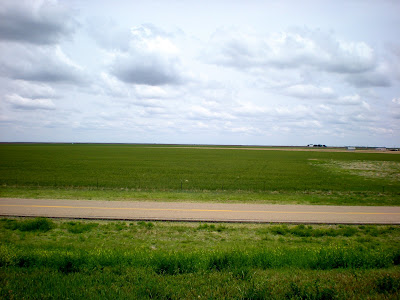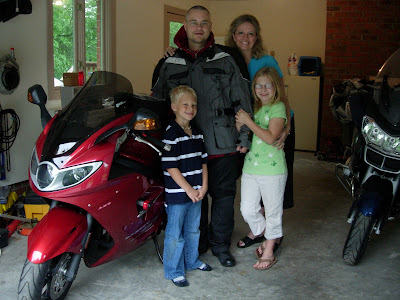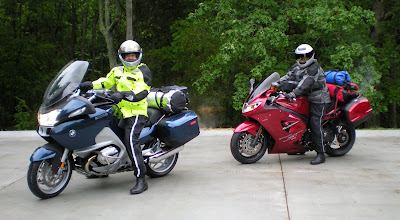 We had a great ride through the Grand Teton National Park and a spectacular first day in Yellowstone. The weather was good until our last few miles into West Yellowstone, when it rained on us. But even that didn’t dampen our spirits.
We had a great ride through the Grand Teton National Park and a spectacular first day in Yellowstone. The weather was good until our last few miles into West Yellowstone, when it rained on us. But even that didn’t dampen our spirits.The main difference we noticed immediately between the Grand Teton National Park and Yellowstone is the variety of landscape and features. I won’t take anything away from the Tetons beauty, but as you work through the park, they are just about the only feature to look at (after all, the park is named after them). Yellowstone, however, seems to have an abundance of variety.
Our trip into Yellowstone at this time of year was destined to bring us a mixed bag of weather and a wide range of conditions inside the park. When we entered from the south, there was only a bit of snow and lots of green. After only 10 miles, however, the temperature dropped and the snow cover increased. Snow banks, some over 10 feet high, still lined the roadway (I wish I had taken a photo of a snow bank that towered over an RV). A lake was still frozen. Then, after a drop in altitude, things changed to a more spring-like terrain.
Of course, Yellowstone is known for Old Faithful, which the queen of geysers and the world’s best known geyser. Yellowstone National Park is home to the majority of the world’s geysers and hot springs. My children have never heard of geysers, so allow me a moment to explain how they work. Geysers are hot springs with narrow spaces in their plumbing, usually near the surface of the earth. These constrictions prevent water from circulating freely to the surface where heat can escape. The deepest circulating water can exceed the surface boiling point. The pressure increases with depth. As the water rises, steam forms. The steam expands as it reaches the surface until it is too large to pass through the narrow spaces. At a critical point, the confined steam and bubbles cause the geyser to overflow in a violent way. Tremendous amounts of steam force the water out of the small vents in an eruption. We did not have quite enough time today to explore all the geysers Yellowstone has to offer. That would take days.
We did see some wildlife today, too. Mainly, we saw bison/buffalo and mule deer. Once or twice, as we were riding along, buffalo grazed on the side of the road. This was very interesting to see, as motorists had to slow or stop.
This year is the 20th anniversary of the Yellowstone Fires of 1988, as they are known. Some of you may remember the summer of 1988 and how much Yellowstone was in the news. These fires raged for just over three months, from June 14 until the fall rain and snow arrived in September. Over 500,000 acres of Yellowstone were affected, and over 25,000 firefighters were involved in putting out the fires. You can clearly still see the evidence of the fires 20 years later. The lodgepole pine (the dominant tree in Yellowstone) began to regrow almost immediately, and many of the forests of baby pine stand in stark contrast to mature forests.
Tomorrow, we will continue to explore Yellowstone. We will see more geysers and wildlife, but we also plan to see some waterfalls and the Grand Canyon of Yellowtone as well.
143.4 miles today. 4,853.3total miles.






















